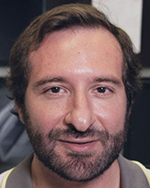 |
||
Home > TERATEC FORUM > Workshops
Workshop 02 - 9:00 to 12:30 pm
HPC Technologies and Health
The Neuroanatomical basis of Brain Energy Metabolism
Par Corrado Calì, PhD, Assistant Professor, Neuroscience Institute Cavalieri Ottolenghi (NICO)
Understanding the mammalian brain’s computational efficiency represent, to date, an ambitious challenge. Growing evidence suggests that the key to unveil such mystery relies in its complex energy management system. Brain energetic demand in particular, seemed to rely on the metabolism of glucose. In the early 90s, the discover that lactate, an intermediate product of the glucose metabolic pathway, plays a central role in neuronal energy supply, brought a paradigm shift into the field. More than 20 years of research highlighted the importance of the astrocyte-neuron lactate shuttle (ANLS), a novel hypothesis describing how glia acts a metabolic bridge between vasculature and neurons (the so-called neuro-glia-vasculature unit, or NGV).
Increasing evidence highlighted the central role of lactate in the physiology of the brain, as well as its benefits in a number of pathological conditions, including stroke, epilepsy and drug addiction. Nevertheless, cellular and molecular mechanisms through which lactate is exerting its function remains still unclear. Although lactate is a well-known byproduct of glycolysis, a series of recent studies have highlighted how lactate derived from glycogen, a storage mechanism of glucose expressed specifically in astrocytes, is pivotal for learning and memory. Following this alternative pathway, we have decided to investigate the localization of glycogen and analyze its distribution in several brain areas and under different physiological and pathological conditions, in order to infer the possible sites of lactate utilization in the brain.
The complex structural arrangements between neurites and glial processes can be hardly resolved with conventional microscopy methods, therefore we decided to adapt microconnectomics techniques based on 3D electron microscopy (3DEM) to extract high-resolution three-dimensional models of brain parenchyma to conduct these assessments. We took extensively advantage of the most recent visualization techniques, and developed virtual reality (VR) tools to perform complex analysis in 3D.
This approach is similar to what early observers like Golgi and Ramon y Cayal used to do, by hypothesizing the functional role of brain components by their morphology but revised using much higher resolution imaging techniques and VR visualization.
 |
Biography: Corrado Calì was trained an electronic engineer at Politecnico di Torino, Italy. He completed his MSc in 2006, in the lab of Henry Markram at EPFL (Lausanne, Switzerland), where he became interested in neuroscience. In the same year he joined the lab of Paola Bezzi at UNIL (University of Lausanne, Lausanne, Switzerland), where he got his doctoral degree in 2012. His research was focused in elucidating the physiological role of astroglial cells in the modulation of synaptic transmission, by releasing neuroactive compounds (so called "gliotranmsission"). After one year as postdoctoral fellow in Graham Knott’s lab, where he enriched and deepend his skills in the state-of-the-art electron microscopy techniques, he joined Pierre Magistretti’s lab in KAUST (King Abdullah University of Science and Technology, Thuwal, Saudi Arabia). Here, he investigated the mechanisms of metabolic support of astrocytes to neurons using morphological and 3D imaging approaches. In particular, he pioneered the use of VR (virtual reality) in neuroscience and is actively exploring scientific visualization approaches for explorative analysis of sparse and dense reconstructions of the CNS from serial-section Electron Microscopy. His interests in 3D visualization and augmented reality led him to establish a company, Intravides (Torino, Italy) with a more clinical focus, developing an Augmented Reality medical device to assist and improve neurosurgical training and practice. Since February 2020, he joined the department of Neuroscience of the University of Torino (Italy) as assistant professor of Human Anatomy. |
Register now and get your badge here
- TERATEC Forum is strictly reserved for professionals.
- Participation to exhibition, conferences and workshops is free (subject to seats available)
- On line registration is obligatory.